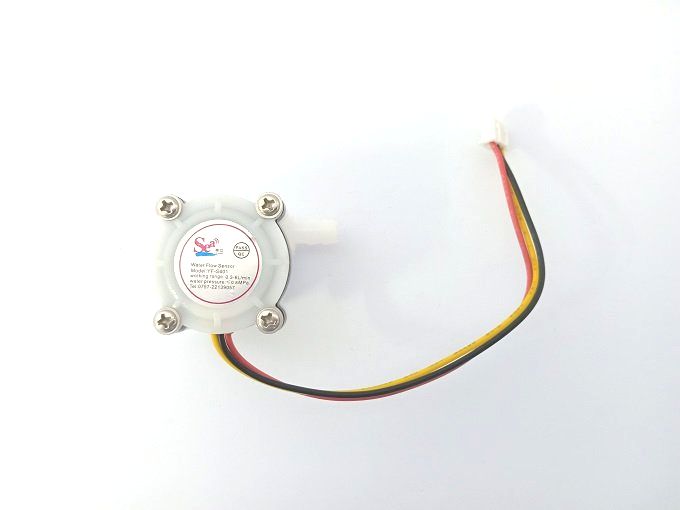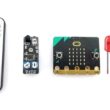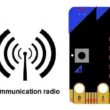The water flow sensor

Water Flow Sensor Definition
A water flow sensor, also known as a flow meter, is an electronic device used to measure the amount of water flowing through a pipe or system. It detects the flow rate of water passing through it and converts it into a measurable electrical signal. Water flow sensors are commonly used in a variety of applications, such as industrial process control, irrigation systems, water treatment plants, and domestic water usage monitoring. They come in various designs and types, including paddle wheel, ultrasonic, and electromagnetic flow meters.
What is the YF-S401 water flow sensor ?
The YF-S401 is a type of water flow sensor that operates using the Hall Effect principle. It is a small, compact device that can measure water flow rates between 0.3 and 6 liters per minute with an accuracy of 3%. The YF-S401 water flow sensor consists of a plastic valve body with a rotor assembly that contains a magnet, and a Hall effect sensor located adjacent to the rotor. As the water flows through the valve, the rotor spins, and the magnet passes by the Hall effect sensor, generating a voltage pulse. The frequency of these voltage pulses is proportional to the flow rate of the water passing through the sensor. The YF-S401 is a commonly used flow sensor in DIY projects, such as for monitoring water consumption, irrigation systems, or water flow in aquariums.
YF-S401 water flow sensor and microcontrollers
The YF-S401 water flow sensor can be easily interfaced with microcontrollers, such as Arduino, Raspberry Pi, or ESP32, to measure and monitor the flow rate of water in various applications. The sensor has a digital output that can be connected to a microcontroller pin to detect the frequency of the voltage pulses generated by the sensor. By measuring the frequency of these pulses, the microcontroller can determine the flow rate of the water passing through the sensor.
To use the YF-S401 water flow sensor with a microcontroller, you will need to connect the power supply and ground pins of the sensor to the corresponding pins of the microcontroller. You will also need to connect the digital output pin of the sensor to a microcontroller pin capable of reading the frequency of the voltage pulses, such as an interrupt pin. Then, in your microcontroller code, you can use the pulseIn() function or attachInterrupt() function to measure the frequency of the pulses and calculate the flow rate based on the sensor's specifications.
How to use YF-S401 water flow sensor by Arduino board ?
To use the YF-S401 water flow sensor with an Arduino board, you need to follow these steps:
1- Connect the sensor to the Arduino board: The YF-S401 sensor has three pins - VCC, GND, and OUT. Connect the VCC pin to 5V on the Arduino board, GND to GND, and OUT to a digital pin (e.g., pin 2).
2- Set up the Arduino board: Open the Arduino IDE and create a new sketch. In the setup function, initialize the serial communication using the Serial.begin() function.
3- Read the sensor data: In the loop function, use the pulseIn() function to read the time it takes for the sensor to detect a certain amount of water flow. You can then use this value to calculate the flow rate in liters per minute (L/min).
Here's an example code to get you started:
|
1 2 3 4 5 6 7 8 9 10 11 12 13 14 15 16 |
const int flowPin = 2; int flowValue; float flowRate; void setup() { Serial.begin(9600); } void loop() { flowValue = pulseIn(flowPin, HIGH); flowRate = 7.5 / flowValue; Serial.print("Flow rate: "); Serial.print(flowRate); Serial.println(" L/min"); delay(1000); } |
In this code, the pulseIn() function reads the time it takes for the sensor to detect a certain amount of water flow, and the flow rate is calculated using the formula flowRate = 7.5 / flowValue. The delay() function is used to wait for 1 second before reading the sensor again.
Note that the formula for calculating the flow rate may vary depending on the specifications of your sensor. You should consult the datasheet of the YF-S401 water flow sensor to determine the correct formula to use.
Role of YF-S401 Water Flow Sensor in Robotic Projects
The YF-S401 water flow sensor can be used in various robotic projects that require precise monitoring and control of water flow. For example, it can be used in:
Aquaponics systems: In aquaponics systems, the water flow needs to be carefully controlled to ensure that the plants receive the right amount of water and nutrients.
Hydroponics systems: Similarly, in hydroponics systems, the YF-S401 water flow sensor can be used to monitor and control the flow of nutrient-rich water to the plants.
Automated watering systems: The sensor can also be used in automated watering systems for gardens or greenhouses. It can detect the flow of water and activate the irrigation system when necessary.
Water conservation systems: The YF-S401 water flow sensor can be used to monitor water usage in homes and buildings, helping to conserve water by detecting leaks and reducing wastage.
Role of YF-S401 Water Flow Sensor in Irrigation Systems
The YF-S401 water flow sensor can play an important role in irrigation systems by measuring the amount of water flowing through the pipes. With this information, the system can be adjusted to ensure that the plants receive the optimal amount of water, which is essential for their growth and health.
For example, if the water flow rate is too high, it may lead to water wastage and potential damage to the plants. On the other hand, if the flow rate is too low, the plants may not receive enough water and could suffer from drought stress. By monitoring the water flow rate using the YF-S401 sensor, the irrigation system can be adjusted accordingly to maintain an optimal flow rate and conserve water while ensuring the health of the plants.
Role of YF-S401 Water Flow Sensor in Cooling Systems
The YF-S401 water flow sensor can be used in cooling systems to measure the flow rate of water or other fluids that are being used to cool a system. By monitoring the flow rate, the sensor can help ensure that the cooling system is functioning properly and that the fluid is being circulated at the correct rate to maintain the desired temperature. This can help prevent overheating and damage to the system. Additionally, the sensor can be used to detect any changes in flow rate that may indicate a problem, such as a blockage or a leak. This can help facilitate maintenance and troubleshooting of the cooling system. Overall, the YF-S401 water flow sensor plays an important role in ensuring the proper operation and maintenance of cooling systems in various applications.
1 comment
D Change 15-11-2323
It's impressive that you are getting ideas from this article as well as from our dialogue made here.
























